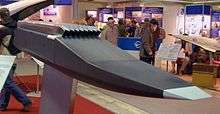GLL-8 (Gll-VK) Igla
GLL-8 (GLL-VK), nicknamed "Igla" (eng. needle), is a Russian hypersonic flight flying laboratory. It saw its first flight in 2005. It is part of Russia's ongoing ORYOL-2-1 research programme. Under ORYOL-2-1, the Gromov Flight Research Institute in Moscow has developed two possible Igla designs,[1][2] and is leading an SSTO spaceplane effort and a two-stage-to-orbit design conceived to build a "Mir-2" space station.[3][1][4][5]
Purpose
The purpose of this "flying laboratory" is technical data study of hypersonic speeds, which cannot be done with average engines, and other manned experimental flight-craft. This study includes the following:
- Aerodynamic properties at hyper sonic speeds
- Maneuverability at different speeds
- G-force effects on fuselage at high speeds
- Scramjet studies[6]
Vehicles associated with the GLL-8

GLL-AP
| Vehicle | Speed | Altitude | Length | Mass | Firing duration | Details |
|---|---|---|---|---|---|---|
| GLL-31 | Mach 2-9 | 18–35 km | 8 m | 3,800 kg | 50 s | Aircraft dropped, hydrogen-fueled scramjet engine |
| GLL-8 (GLL-VK) | Mach 15 | 70 km | 8 m | 2,200 kg | 20-50 s | Rocket-launched, hydrogen-fueled three-mode scramjet engine |
| GLL-AP-02 | Mach 6 | 27 km | 3 m | 550–600 kg | Missing data | Hydrocarbon-based fueled ramjet prototype for high-altitude test stand tests[2] |
References
- "GLL-8 (GLL-VK)". www.globalsecurity.org. Retrieved 4 January 2019.
- Drew, James (28 August 2015). "MAKS: Russia's hypersonic scramjet experiment could fly by 2019". Flightglobal.com. Retrieved 4 January 2019.
- "Towards hypersonic flight". Flightglobal.com. 26 November 1997. Retrieved 4 January 2019.
- http://www.icas.org/ICAS_ARCHIVE/ICAS2012/PAPERS/869.PDF
- https://www.sipri.org/sites/default/files/Factoring-Russia-into-US-Chinese-equation-hypersonic-glide-vehicles.pdf
- "Hypersonic vehicles". www.russianspaceweb.com. Retrieved 4 January 2019.
External links
This article is issued from Wikipedia. The text is licensed under Creative Commons - Attribution - Sharealike. Additional terms may apply for the media files.